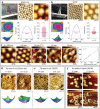3D Generation of Multipurpose Atomic Force Microscopy Tips
- PMID: 35853246
- PMCID: PMC9507387
- DOI: 10.1002/advs.202201489
3D Generation of Multipurpose Atomic Force Microscopy Tips
Abstract
In this work, 3D polymeric atomic force microscopy (AFM) tips, referred to as 3DTIPs, are manufactured with great flexibility in design and function using two-photon polymerization. With the technology holding a great potential in developing next-generation AFM tips, 3DTIPs prove effective in obtaining high-resolution and high-speed AFM images in air and liquid environments, using common AFM modes. In particular, it is shown that the 3DTIPs provide high-resolution imaging due to their extremely low Hamaker constant, high speed scanning rates due to their low quality factor, and high durability due to their soft nature and minimal isotropic tip wear; the three important features for advancing AFM studies. It is also shown that refining the tip end of the 3DTIPs by focused ion beam etching and by carbon nanotube inclusion substantially extends their functionality in high-resolution AFM imaging, reaching angstrom scales. Altogether, the multifunctional capabilities of 3DTIPs can bring next-generation AFM tips to routine and advanced AFM applications, and expand the fields of high speed AFM imaging and biological force measurements.
Keywords: 3D printing; carbon nanotubes; focused ion beam; high-resolution imaging; high-speed imaging; polymeric atomic force microscopy tips.
© 2022 The Authors. Advanced Science published by Wiley-VCH GmbH.
Conflict of interest statement
The authors declare no conflict of interest.
Figures







Similar articles
-
Carbon nanotube tips for atomic force microscopy.Nat Nanotechnol. 2009 Aug;4(8):483-91. doi: 10.1038/nnano.2009.154. Epub 2009 Jul 13. Nat Nanotechnol. 2009. PMID: 19662008 Review.
-
Focused Helium Ion and Electron Beam-Induced Deposition of Organometallic Tips for Dynamic Atomic Force Microscopy of Biomolecules in Liquid.ACS Appl Mater Interfaces. 2024 Jan 31;16(4):4439-4448. doi: 10.1021/acsami.3c16407. Epub 2024 Jan 20. ACS Appl Mater Interfaces. 2024. PMID: 38244049
-
Diamond-modified AFM probes: from diamond nanowires to atomic force microscopy-integrated boron-doped diamond electrodes.Anal Chem. 2011 Jun 15;83(12):4936-41. doi: 10.1021/ac200659e. Epub 2011 May 18. Anal Chem. 2011. PMID: 21534601
-
High-resolution noncontact atomic force microscopy.Nanotechnology. 2009 Jul 1;20(26):260201. doi: 10.1088/0957-4484/20/26/260201. Epub 2009 Jun 10. Nanotechnology. 2009. PMID: 19531843
-
Structural and functional imaging with carbon nanotube AFM probes.Prog Biophys Mol Biol. 2001;77(1):73-110. doi: 10.1016/s0079-6107(01)00011-6. Prog Biophys Mol Biol. 2001. PMID: 11473787 Review.
Cited by
-
Tailored Microcantilever Optimization for Multifrequency Force Microscopy.Adv Sci (Weinh). 2023 Nov;10(33):e2303476. doi: 10.1002/advs.202303476. Epub 2023 Oct 22. Adv Sci (Weinh). 2023. PMID: 37867232 Free PMC article.
References
MeSH terms
Substances
Grants and funding
LinkOut - more resources
Full Text Sources
Miscellaneous
